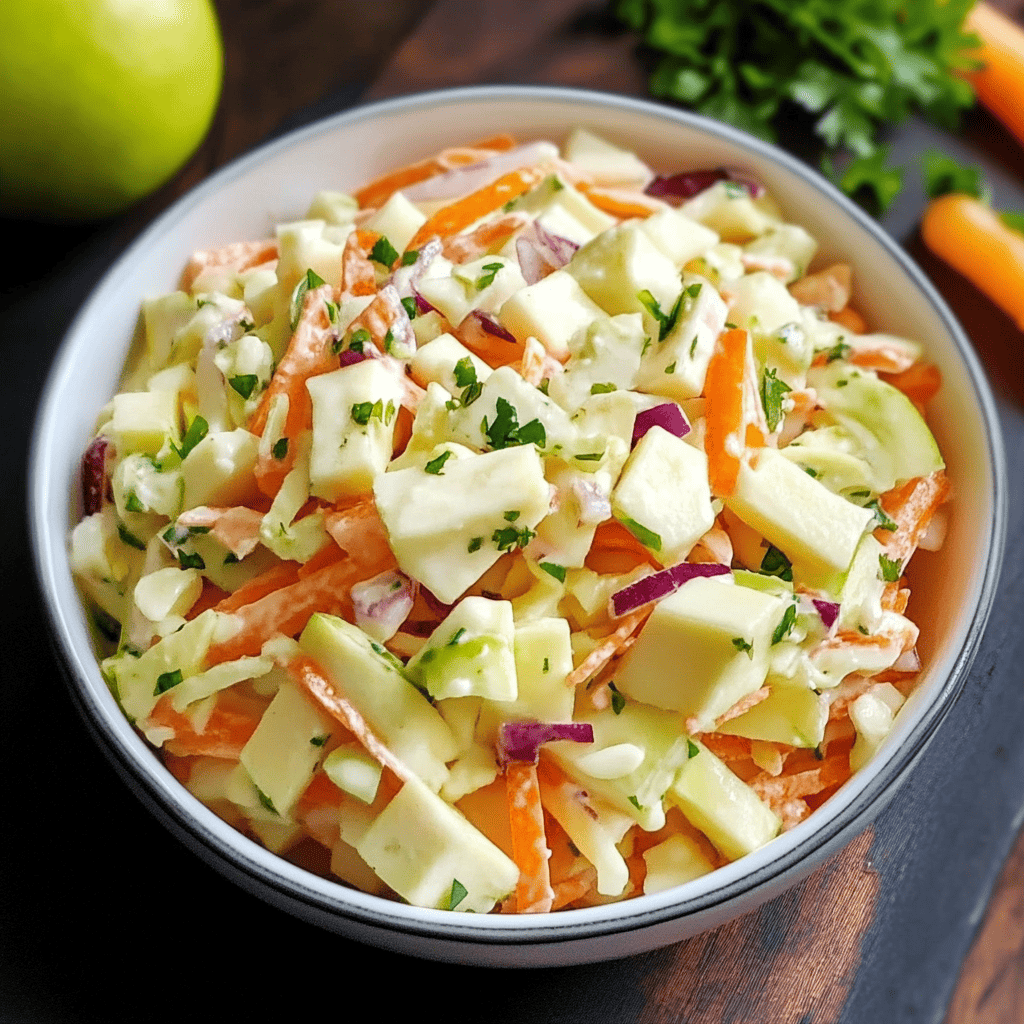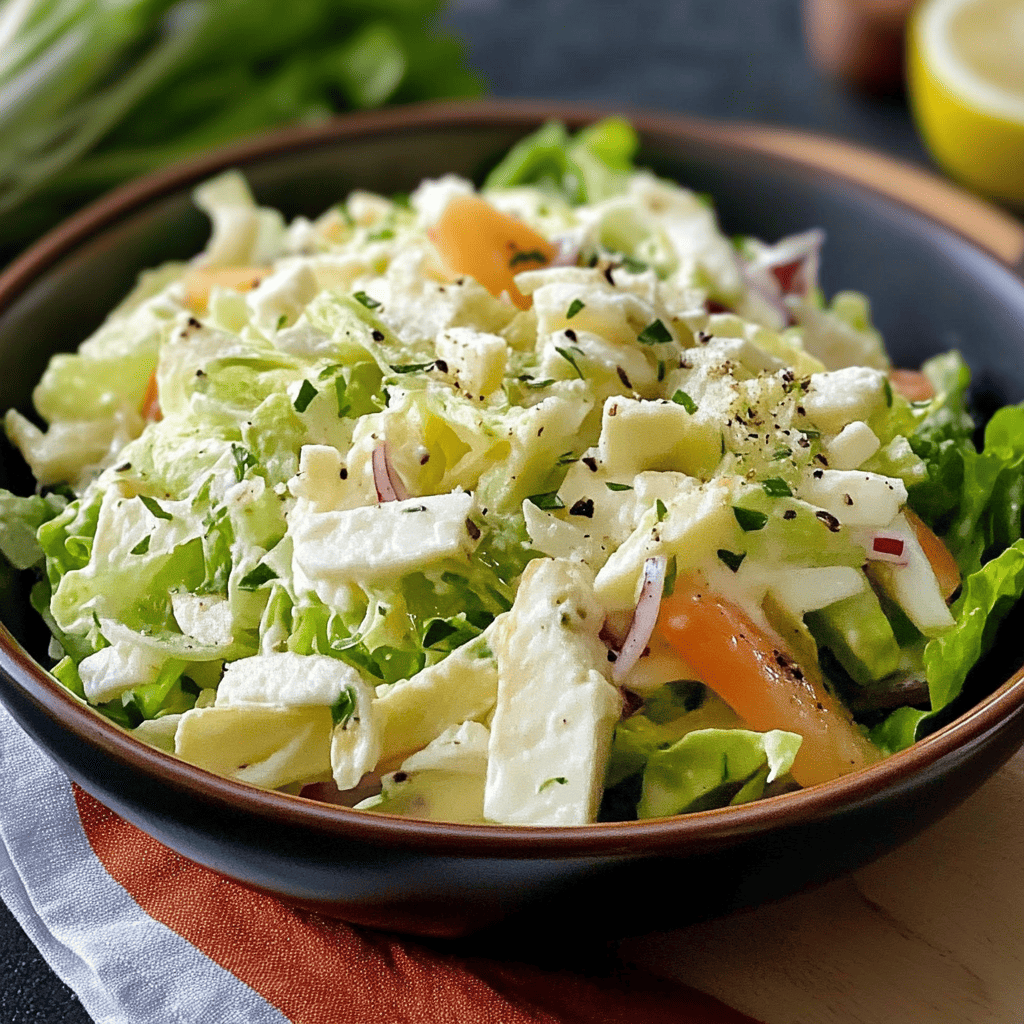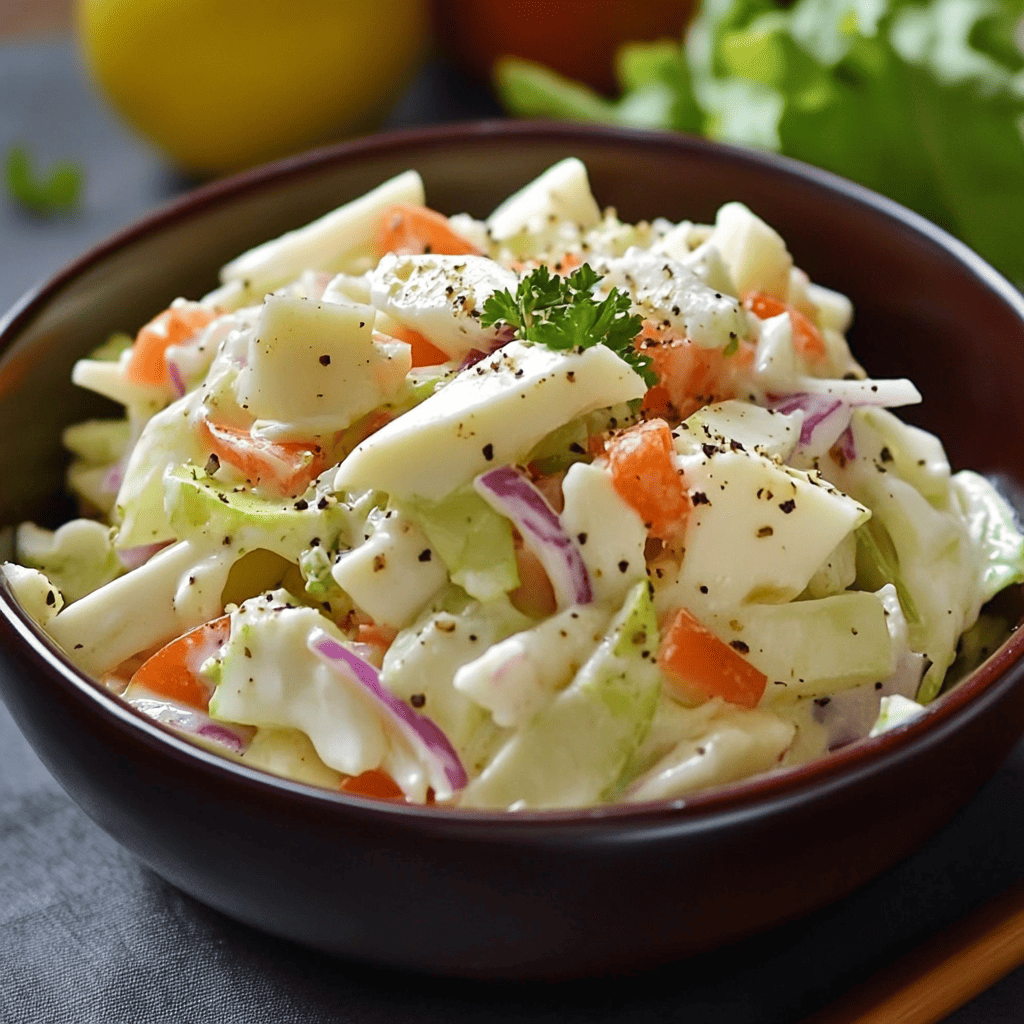American Coleslaw and Apple Salad: The Classic Reborn with a Fresh and Vibrant Twist
Introduction: A Timeless Accompaniment with a Soul of Its Own
The “American Apple and Cabbage Salad,” commonly known as coleslaw , is much more than a simple side dish; it’s a culinary icon that has transcended borders, adapting to countless tastes and occasions. Its essence lies in the perfect combination of crunchy textures and a creamy dressing that envelops each strand of cabbage. However, this particular version elevates the classic by incorporating the freshness and subtle sweetness of apple, along with a balanced dressing that fuses the richness of mayonnaise with the lightness of yogurt and the acidity of apple cider vinegar. The result is a visually appealing dish, with its flashes of white, orange, and green, and a flavor profile that is both comforting and surprisingly refreshing. It’s the ideal choice for adding a vibrant and nutritious touch to any meal, from a casual barbecue to a more elaborate dinner.
Detailed History: A Journey Through the Origin and Evolution of Coleslaw
The history of coleslaw is as rich and varied as its ingredients. Its name, “coleslaw,” comes from the Dutch “koolsla,” an abbreviation of “koolsalade,” which literally means “college salad.” Cabbage, or kale, has been a staple food in many cultures since ancient times, valued for its hardiness, ease of cultivation, and high nutritional content. The Romans already prepared a type of vinegar-based cabbage salad, but the creamy version we know today has its roots in the Netherlands.
Dutch settlers brought the koolslaw recipe to America, where it quickly became popular, especially in the South. In the early days, dressings were varied, often based on vinegar, spices, and even melted butter. It wasn’t until the late 18th century, with the invention of mayonnaise and its subsequent large-scale production in the 19th century, that this sauce became the main and almost indispensable component of coleslaw dressing .
Coleslaw became a ubiquitous side dish in American cuisine, serving as an ideal complement to robust dishes like fried chicken, pulled pork, or barbecue. Its popularity grew, and with it, the diversity of its variations. Some versions are sweeter, others more tangy, and many include additional ingredients like carrots, onions, or peppers.
The addition of apple to coleslaw , as in our recipe, is a natural evolution intended to add a touch of freshness, natural sweetness, and an additional crunchy texture. This addition not only enhances the flavor but also lightens the overall profile of the dish, making the salad more appetizing and refreshing. Furthermore, the use of apple cider vinegar and the choice of yogurt alongside mayonnaise in the dressing demonstrate a more modern trend toward a balance between traditional flavor and healthier options. Apple cider vinegar not only adds acidity but also a slight sweetness and a fruity aroma that complements the fresh apple.
More Details of the Story: Coleslaw as a Canvas for Culinary Creativity
Throughout the 20th century and continuing to the present day, coleslaw has proven to be a true canvas for culinary creativity. Every region, and often every family, has its own favorite version, with slight variations that make it unique. The “American Cabbage and Apple Salad” is an example of how a classic dish can be adapted to contemporary tastes without losing its comforting essence.
The combined use of natural yogurt and mayonnaise in the dressing is a modern technique that seeks to reduce the richness of pure mayonnaise, offering a lighter option with a touch of fresh acidity. This trend reflects the growing interest in healthy eating and the search for nutritional balance in everyday dishes. The sesame seeds, although optional in this recipe, are an addition that suggests a more global influence, providing not only a crunchy touch but also a toasted, nutty flavor that harmonizes with the other ingredients.
In short, coleslaw has traveled from the Dutch kitchens to become a culinary icon in many countries, especially in North America. This “American Cabbage and Apple Salad” is an example of that evolution, a dish that pays homage to its roots while adapting to current preferences, combining a classic flavor with a refreshing and nutritious twist. It’s a salad that encapsulates the history of popular cuisine, its adaptability, and its constant search for perfection in the balance of flavors and textures.

Ingredients: A Crunchy and Creamy Combination
For the Salad Base:
- 250g cabbage or white cabbage, finely chopped or julienned
- 2 medium carrots, peeled and grated
- 1 green or red apple, peeled and cut into thin sticks (or small cubes)
- Juice of 1 fresh lemon
For the Creamy Dressing:
- 125 ml of natural yogurt (unsweetened)
- 125 ml of good quality mayonnaise
- 2 tablespoons of apple cider vinegar
- 1 tablespoon of sugar (or substitute to taste)
- 1 tablespoon sesame seeds (optional, for a nutty touch and crunch)
- Salt to taste
Detailed Preparation Instructions: Steps for the Perfect Salad
Step 1: Prepare the Solid Ingredients
- Cutting the Cabbage: Wash the cabbage thoroughly. Remove any damaged outer leaves. Cut the cabbage into very thin strips (julienne). The fineness of the cut is crucial for the texture of the salad. You can use a sharp knife, a mandoline (with extreme caution), or a food processor with a julienne or fine grating disc. Once cut, place it in a colander.
- Grating Carrots: Peel two medium carrots. Grate them on a coarse grater. This will add color and a softer texture than cabbage.
- Cutting the Apple: Peel the green or red apple. You can cut it into thin sticks for a more uniform appearance with the cabbage, or into small cubes if you prefer. The green apple will add more acidity and freshness, while the red one will be sweeter.
- Lemon Juice: Squeeze the fresh lemon and reserve the juice. This will be used to drizzle the apple and for the dressing.
Step 2: Mix the Solid Ingredients and Prevent Oxidation
- In a large bowl, roomy enough to mix comfortably, combine the finely chopped cabbage, grated carrot, and sliced apple.
- Immediately after adding the apple, generously sprinkle the entire mixture with the freshly squeezed lemon juice. Lemon juice not only adds a touch of freshness and acidity to the salad, but it’s also essential for preventing the apple from oxidizing and browning, keeping it looking appetizing.
- Mix all the dry ingredients well so that the lemon juice is evenly distributed.
Step 3: Prepare the Creamy Dressing
- In a separate container (a medium bowl is ideal), pour the natural yogurt and mayonnaise.
- Add the 2 tablespoons of apple cider vinegar and 1 tablespoon of sugar. If desired, you can adjust the amount of sugar to suit your sweetness preference.
- If you decide to use sesame seeds (optional), add them to the dressing now.
- Add a pinch of salt. The amount of salt will depend on the saltiness of the mayonnaise and your personal taste, so it’s best to start small and adjust later.
- Using a whisk or fork, mix all the ingredients until you have a smooth, even sauce with no lumps. The texture should be creamy but fluid.
- Taste and Adjust the Dressing Flavor: This step is crucial. Taste the dressing and adjust the sweetness (more sugar), acidity (more vinegar or lemon), or saltiness to your liking. Remember, the dressing is the soul of the salad.
Step 4: Combine the Salad and Refrigerate
- Pour all of the creamy dressing over the cabbage, carrot, and apple mixture in the large bowl.
- Using two large spoons or spatulas, gently stir all the ingredients together. Make sure every strand of cabbage, every piece of carrot and apple is well coated in the sauce. The key is to mix gently so as not to damage the textures, but thoroughly.
- Once well mixed, cover the bowl with plastic wrap or a tight-fitting lid.
- Essential Refrigeration: Refrigerate the salad for at least 1 hour before serving. This resting time is vital. It allows the flavors to blend and intensify, the cabbage to soften slightly, and the salad to reach a chilled temperature, making it much more refreshing and delicious.
Estimated Preparation Time
- Active Preparation: 15-20 minutes
- Refrigerator Resting Time: Minimum 1 hour (ideally 2-3 hours for the flavors to blend better)
- Estimated Total Time: 1 hour 15 minutes to 2 hours 20 minutes
Additional Tips for a Perfect ColeslawPerfect
- Even Cutting: The key to optimal texture is to cut the cabbage and apple evenly and as thinly as possible. If the cabbage is too thick, the salad will be more fibrous.
- Drying the Cabbage: Although the recipe doesn’t explicitly mention it, after cutting and washing the cabbage, it’s a good idea to dry it a little (using a salad dryer or paper towels) to prevent the salad from becoming soggy.
- Firm Apple: Use a crisp, firm apple, such as a Granny Smith (green) or a Fuji (red). Avoid mealy apples.
- Adjusting Sweetness and Acidity: The ratio of sugar to vinegar in the dressing can be adjusted to your taste. If you prefer a more acidic coleslaw , reduce the sugar slightly; if you want it sweeter, add a little more.
- Toasted Sesame Seeds: To enhance the flavor of sesame seeds, you can lightly toast them in a dry pan over medium heat for a few minutes before adding them to the dressing.
- Prep Ahead: This salad benefits from being prepared in advance, but not too far in advance. A refrigerated time of 1 to 3 hours is ideal. If left for more than 4-6 hours, the cabbage may become too soft and release liquid. If not eating immediately, store the dressing and vegetables separately and toss them together an hour before serving.
- Variations: You can add other vegetables such as finely chopped celery, very finely chopped red onion (for a more intense touch) or even a little grated bell pepper for more color and flavor.

Frequently Asked Questions and Clear Answers
- Can I use only mayonnaise or only yogurt? Yes, you can. If you use only mayonnaise, the salad will be richer and more caloric. If you use only yogurt, it will be lighter and more acidic. The combination seeks a balance between the two.
- What kind of cabbage is best? White cabbage is the traditional base. You can add a little red cabbage for a pop of color, but if you use only red cabbage, the color of the dressing may become tainted.
- Can you freeze coleslaw ? Freezing coleslaw is not recommended due to the high water content of the vegetables and the creamy base of the dressing, which can drastically change its texture when thawed, making it watery and mushy.
- How long does it last? Refrigerated in an airtight container, the salad will keep well for 1-2 days, but its best texture and flavor are enjoyed within the first few hours.
- Can I use a different type of vinegar? Yes, you can use white wine vinegar or regular apple cider vinegar, although apple cider vinegar adds a unique sweetness and aroma that complements the apple well.
Texture and Flavor: A Refreshing and Harmonious Experience
- Texture: American Cabbage and Apple Coleslaw is a feast of textures. The finely shredded cabbage provides a crisp, fresh base. The grated carrot adds a soft texture with a slight “inside.” The thinly sliced apple adds a juicy and refreshing crunch. The dressing, with its blend of yogurt and mayonnaise, is creamy and smooth, enveloping all the ingredients and adding a smoothness. Adding sesame seeds adds a nice little crunch.
- Flavor: The flavor profile is a harmony of sweet, sour, and creamy. The sweetness comes from the sugar and apple, complemented by the mayonnaise. The vibrant acidity of the lemon and apple cider vinegar cuts through the richness of the dressing, balancing the flavors and providing freshness. The plain yogurt introduces a slight zesty, milky note. The vegetables contribute their signature earthy flavor, while the sesame seeds, when used, offer a subtle toasted nuttiness. It’s a comforting, familiar flavor, but with a distinctive twist that makes it more refreshing and appealing.
Consumption Context: When to Enjoy It?
This salad is extremely versatile and is a perfect accompaniment to a wide range of dishes:
- Barbecues and Grills: It’s a classic staple at any barbecue, ideal for accompanying ribs, roast chicken, hamburgers, or sausages.
- Casual Dining: Perfect for picnics, potlucks, or casual family meals.
- Sandwiches and Wraps: Excellent as a filling or accompaniment to pulled pork sandwiches, grilled chicken, or even in a wrap with some protein.
- Fried Dishes: Complements the richness of fried dishes such as fried chicken or breaded fish, providing a fresh contrast.
- Light Lunches: This can be a refreshing option as a light main course, especially on hot days.
- Family Dinners: An easy and delicious side dish that almost everyone likes.
Visual Aspect: A Dish That Invites You to Savor
The image of the American Cabbage and Apple Coleslaw is an example of its visual appeal:
- Contrasting Colors: The predominant white of the cabbage, the vibrant orange of the carrot, and the touches of green and purple (if using purple cabbage, although this recipe specifies white, the image shows some) create a very appetizing color palette.
- Visible Texture: The different textures of grated and chopped vegetables are clearly visible, suggesting a crunchy experience.
- Appetizing Creaminess: The creamy white dressing evenly coats the ingredients, giving them a succulent, well-blended appearance.
- Fresh Touch: Sprinkling fresh chopped parsley (as seen in the image) adds a touch of color and freshness that enhances the presentation.
- Elegant Simplicity: It is a dish simple in its composition, but its orderly and colorful presentation makes it elegant and appetizing.
Curiosities: Interesting Facts about the Ingredients
- Cabbage and Vitamin C: Cabbage is an excellent source of vitamin C. Historically, it was used on ships to prevent scurvy on long voyages.
- Apples and Oxidation: The oxidation of apples when cut is caused by an enzyme called polyphenol oxidase, which reacts with oxygen. Lemon juice, rich in vitamin C (an antioxidant), helps inhibit this reaction.
- Origin of Mayonnaise: Although its origin is debated, mayonnaise is an emulsion of oil, egg yolk, and an acid (such as vinegar or lemon). It is believed to have originated in Mahón, Menorca, in the 18th century.
- Benefits of Apple Cider Vinegar: Apple cider vinegar not only provides flavor, but is also credited with benefits for digestion and blood sugar control.
- Sesame seeds: One of the oldest cultivated oilseeds, they are valued for their oil and their use in the cooking of various cultures. They provide calcium and fiber.
Nutritional Value (Estimated per Serving)
Nutritional values are approximate and may vary significantly. For a generous portion of this salad (approximately 150-200g), we can estimate:
- Calories: 180-250 kcal (depending on the amount of mayonnaise and sugar)
- Protein: 2-4g (mainly from yogurt and mayonnaise)
- Total Fat: 15-20g (mainly from mayonnaise and, if used, sesame seeds)
- Carbohydrates: 15-25g (from vegetables, apple, sugar)
- Fiber: 3-5g (high in fiber due to cabbage and carrot)
- Sugars: 8-15g (natural sugars from the apple and added sugar)
- Sodium: 150-300mg (depends on added salt and mayonnaise)
Additional Benefits and Interesting Facts
- Rich in Fiber: The combination of cabbage and carrots makes it an excellent source of dietary fiber, essential for digestive health.
- Vitamins and Minerals: Provides vitamins C (cabbage, lemon, apple), K (cabbage), and A (carrot), in addition to several minerals.
- Hydrating: With its high water content from the vegetables and dressing, this is a very hydrating salad, ideal for warm climates.
- Seasonal Versatility: Although the ingredients are available year-round, it is especially refreshing in spring and summer.
- Customizable: The recipe is a fantastic base for experimentation. You can add different herbs, spices, or even other fruits or nuts.
Other Information
- Allergies: This dish contains egg (in the mayonnaise) and dairy (in the yogurt). Sesame seeds are another common allergen.
- Vegetarian Diet: This is a vegetarian salad, but not vegan due to the mayonnaise and yogurt. It can be adapted for vegans with vegan mayonnaise and plant-based yogurt.
- Party Prep: For large gatherings, you can prepare the vegetables and dressing separately, then combine them just a few hours before the event.

Conclusion: The Crunchy and Creamy Touch That Every Food Deserves
American Coleslaw and Apple Salad is a culinary gem that proves that simplicity can be the key to deliciousness. With its perfect balance of crunchy textures and a creamy dressing, its combination of sweet and tangy flavors, and its vibrant visual appeal, this coleslaw is a surefire side dish that enhances any meal. Beyond its familiarity, its touch of fresh apple and balanced dressing elevate it to a level of its own, offering a refreshing and satisfying experience. It’s a dish that encapsulates the essence of home cooking, inviting you to share and enjoy the simple yet profound pleasures of good food. Without a doubt, a classic that never goes out of style.

